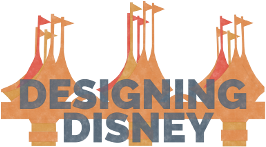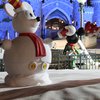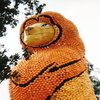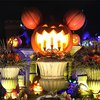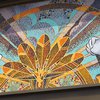Creating Disney Magic – Lighting Design
Dream of a wintery world where imagination swirls like falling snow.
Share in the warmth of the holidays and let your heart shine with joy.
This is the season of light.
LuminAria, Disney California Adventure Park, 2001 – 2002.
Walt Disney loved to be in Disneyland at sundown to see the lights come on. It seemed to him that “a new kind of magic is taking over in Disneyland after dark”. And in our humble opinion, this statement couldn't be more true! That’s why we decided to dedicate this years ‘Designing Disney’ Christmas series to the different ways nighttime magic is made during the holiday season at Disneyland Paris.
In the first installment, Tracy Eck (Walt Disney Imagineering Creative Paris) tells you about how light is used at the parks and hotels to achieve a particular practical or aesthetic effect. Ms. Eck was a lighting designer at Disneyland Paris for many years. Since April 1, 2011, she is the art director for the Disneyland Park. In 2002, Ms. Eck was named Lighting Dimensions International's "Lighting Designer of the Year".

Designing Disney (DD): What is the function of light in the Disney Parks and Resorts?
Tracy Eck (TE): I like to think of lighting as the glue that pulls the different elements of an attraction together and makes it all coherent. Because it accents the things you want to see and makes the things you don’t want to see go away. I love to take people into an attraction under work lights, turn the work lights off and turn the show lights on and let them see how it totally transforms the space. And that is what lighting does. It finishes the whole picture and makes the vision come true.

DD: What are the main steps of the lighting design process?
TE: The process starts in concept. Based on the story, the lighting designer will figure out what a particular room should look like. He or she will decide which parts of a particular space will have to be lit. Parts that may not be seen will deliberately be left in the dark. The lighting designer will also select the places where shadow should be dropped. Shadow management and shadow design is as important as lighting itself. Because shadow is what gives things depth. It pulls things forward and makes them go back, influencing the perceived scale and dimension. So the first step in the process is all about shadow, leaving darkness and controlling what the light hits and focusing the viewers eye.

Once it has been decided what needs to be lit, the lighting designer will determine how that should be done. He or she will chose the angle and width of the light beam and select the place where the light source should be installed. He or she can choose between front light, back light and side light. They all produce different effects and shadows. Front light is often a little bit flat. So by adding back light, you make the silhouettes stand out. If you want something a little dramatic, you could have just one source that hits the object from the side. That will create a very strong shadow. But the possibilities will often be limited by the small amount of space available. There are air conditioning docs, there is emergency lighting and a whole bunch of other stuff that has to fit into the same space. So the lighting designer will have to negotiate with the set and audio people to get space for their lighting equipment in the right place.

The lighting designer will also have to pick the color of the light. When you put a light up, it has its own color. That’s something people often tend to forget. There are all sorts of white light. Some is very blue, while other is very orange. The lighting designer will choose a type of white that works well with color. There are some kinds of white light that kill color, while others make the colors pop. This is called color rendition. Color rendition is the ability of a light source to faithfully reproduce the colors of objects the same way sunlight does. It’s measured by a 1-100 index (Color Rendition Index or “CRI”). An incandescent light bulb has a CRI of 100. And then, if you remember those horrible tunnel lights, they are a kind of orange and they make all the colors go grey, that would be probably 30. So if you buy light bulbs, look at the CRI. It tells you how true your colors will look. At Disney, we try to stay around 90 and not below 80.

When it has been decided what needs to be lit and how that should be done, the lighting designer will do renderings and simulations to see, and show others, what his or her lighting design is going to look like. Once the design is finished, the engineers will determine the technical installations needed to ensure the implementation of it. And the necessary lighting equipment will be bought. During the construction of the space for which a lighting design was made, the lighting designer will make sure that all technical installations are build and that the space that was allocated for the lights is left open. When the construction is finished and the painters, set designers and the people doing the floors and audio went home, the lighting designer will come in and install its lighting equipment. This phase is called “test and adjust”. That’s the time when you’re aiming the lights, coloring them and setting levels.
DD: What elements are taken into account while selecting the appropriate lighting equipment?
TE: Things are here for ten, twenty, thirty, forty or fifty years. So the lighting equipment must hold up over time, despite heavy use and terrible weather conditions. It has to be as easy to maintain as possible. After all, you don’t want to have to go and change light bulbs all the time. The lighting equipment must be energy efficient and comply with all applicable regulations. And you want things to look good, so you also have to keep an eye on the color rendition.

All these elements were taken into account when we relid “Rock ‘n’ Roller Coaster”. A few years after the opening of the Studios park, it became apparent that because of the rather short lamp life and the many moving parts, there was too much maintenance involved in keeping the attraction’s lighting equipment up and running. So the maintenance team asked us to look at it again and to try and find lights that are easier to maintain. By that time, the moving light manufacturers had just gotten into the LED world. And using LED lighting seemed to cover our needs. When you work with LED’s, all of the color changing is done via RGB color mixing. And seen as you have fewer moving parts, you take away some of the maintenance.

So we looked at every LED moving head on the market. We brought maintenance in so that they could open up the equipment and see if the (moving) parts looked like they were going to last over time. Then we brought the moving heads we liked into the attraction and we tested the quality of the light they produced. We looked at the colors, the color changing, the color mixing, how quickly we could change the colors. Once we made the final selection, we installed the LED moving heads in the attraction and we let them run twenty four seven for several months to see how they held up. And now, maintenance is really happy with the result. The new lights cut their work down and the quality of the show has gone up tremendously.
DD: How is the outdoor lighting being controlled (switched on and off)?
TE: I love the moment of the day when the outdoor lighting is about to be switched on. It’s what we, lighting designers, call the magic hour. That’s when daylight is falling, twilight is deepening into night and it gets darker bit by bit. And then, all of a sudden, the lights come up and you see guests being totally amazed by it. It’s when nighttime magic comes to life. So turning the outdoor lighting on is a huge thing!

In order to turn things on and off in an efficient way, we’re using a computerized lighting control system. In the Disneyland Park, the system is 20 years old. It’s a simple but reliable one. In the Walt Disney Studios Park, we have a more sophisticated lighting control system that enables you to do more precise things.
The system allows you to program when and how the outdoor lighting should be switched on. Do you want the lights to come up slowly, for a little bit of an effect? Or does it need to be bright at the beginning and then dim a little bit? After all, what you need at twilight is brighter then when it’s really dark. Once you have set the parameters right, the system cycles through the program as recorded all day long.
DD: How does the use of light differ from land to land?
TE: The biggest, simplest visual cue is what we call the “themed lighting”. This is all the decorative lights that you can see: the lampposts, wall lamps… We have a department in Glendale that does nothing but designing these lights for us. When creating a decorative light, they start with the story. For example, if we need something for Frontierland, they will look into the history of the Old West. There are very clear references to what the lamps looked like in those days. Based on the outcome of their research, they will determine the look of the light fixture. Subsequently, they’ll have to recreate the appropriate lighting effect. Back in the 1900’s, people had oil lamps. But we’re not going to use oil. That gives no light and has a limited lamp life. In order to stay true to the story, inventive solutions need to be found to recreate the effect of an oil lantern. And that’s when modern technology comes into play. You can put LED lights in a lantern, frost the glass so guests don’t really see what’s going on inside and then program the LED’s so that the light resembles the flickering flame of a real oil lamp.

The problem with some of the themed lights is that, although they look very pretty, they aren’t that efficient as a light source. For example, a little candle won’t be sufficient to light an entire room. So often, there is what I call a “workhorse”, a much stronger light source, hidden in the light fixture that does the real lighting work. The guest has the impression that the light is coming from the little candle, but the concealed source is actually doing all the work.


DD: What’s your favorite place in DLP after dark?
TE: I love Main Street, with all the rim lights. The Castle and exteriors of Fantasyland are gorgeous! And I think Toy Story Playland is very cute, with those great, big light bulbs hanging over the pathways. The interiors of Tower of Terror and Pirates are beautiful too! And the Temple of Peril! I really loved lighting that. That was fun! Oh, there are so many things to like. It’s very difficult to only select a few. I think my choice depends on the day and the mood (laughter). You know, it’s a question of the sets and the lighting working together. It’s not really lighting all by itself… After all, lighting can’t be seen until it strikes something, smoke or an object. So what it is that the lighting is striking, is critical to how nice the lighting design looks. When you have something beautiful, lighting only makes it better!




DD: Ms. Eck, thanks a million for taking the time to answer our questions!

This article is part of our ‘Sparkling Christmas at Disneyland Paris” series, celebrating the different ways nighttime magic is made during the holiday season at Disneyland Paris!

Credits
Photo Nr 1: Disney
